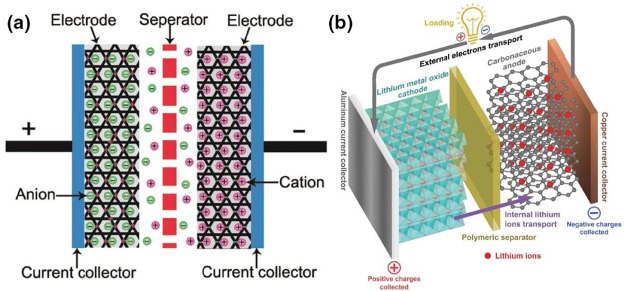Graphene Batteries To Meet The Growing Demand Of Future

2 Mar
2023
Graphene is a revolutionary material that has the potential to transform various industries, and the battery market is no exception. Graphene batteries are poised to become the future of energy storage, with their superior performance and durability over traditional batteries.
Graphene is a one-atom-thick layer of carbon atoms arranged in a hexagonal lattice, and it is the thinnest and strongest material known to mankind. Its unique properties, including high electrical conductivity, high surface area, and excellent mechanical strength, make it an ideal material for use in batteries.
The global graphene battery market is expected to grow significantly in the coming years due to the increasing demand for energy storage solutions, particularly in the automotive and electronics industries. The global graphene battery market was valued at $48.8 million in 2019 and is projected to reach $398.6 million by 2027, to register a CAGR of 31.2% during the forecast period
One of the key advantages of graphene batteries is their high energy density, which refers to the amount of energy that can be stored in a given volume or weight. Graphene batteries have a higher energy density than traditional lithium-ion batteries, which are currently the most widely used type of rechargeable batteries. This means that graphene batteries can store more energy in a smaller and lighter package, making them ideal for use in electric vehicles and portable electronic devices.
Graphene batteries also have a longer lifespan compared to traditional batteries. Lithium-ion batteries, for instance, can typically be recharged around 500 times before their performance starts to degrade. Graphene batteries, on the other hand, can be recharged up to 3,000 times without any significant loss in performance. This means that graphene batteries have a much longer lifespan and require less frequent replacement, reducing the overall cost of ownership.
In addition to their superior performance, graphene batteries are also more environmentally friendly than traditional batteries. Graphene is a sustainable and abundant material, and its production does not require any toxic chemicals or heavy metals. This means that graphene batteries have a much lower environmental impact compared to traditional batteries, which often contain hazardous materials that can harm the environment and human health.
Several companies are already working on developing graphene batteries for commercial use. For instance, the UK-based company Zap&Go has developed a graphene supercapacitor that can be charged in just five minutes and has a lifespan of up to 100,000 cycles. The company is currently working on integrating its technology into electric vehicles and portable electronic devices.
Another company, Graphene 3D Lab, has developed a graphene-enhanced lithium-ion battery that has a higher energy density and can be recharged more times than traditional lithium-ion batteries. The company is also exploring other potential applications for its graphene-enhanced batteries, including in the aerospace and medical industries.
However, there are still some challenges that need to be overcome before graphene batteries can become widely adopted. One of the main challenges is the cost of production, as graphene is still a relatively expensive material to produce. This means that graphene batteries are currently more expensive than traditional batteries, which could limit their adoption in the short term.
Another challenge is scaling up the production of graphene batteries to meet the growing demand. Graphene production is still a relatively slow and expensive process, and scaling up production to meet the demands of the battery market will require significant investments in research and development.
Despite these challenges, the potential benefits of graphene batteries are too significant to ignore. As demand for energy storage solutions continues to grow, graphene batteries are poised to become a major player in the battery market, offering superior performance, longer lifespan, and lower environmental impact than traditional batteries. With ongoing research and development, the cost of production is expected to decrease, making graphene batteries more accessible and affordable for consumers and businesses alike.

Koyel Ghosh
Author’s Bio- Koyel Ghosh is a blogger with a strong passion and enjoys writing in miscellaneous domains, as she believes it lets her explore a wide variety of niches. She has an innate interest in creativity and enjoys experimenting with different writing styles. A writer who never stops imagining, she has been serving the corporate industry for the last five years.
Increasing Demand For Health Monitoring Devices is Expanding the Growth of the Global Smartwatch Industry
Avenue: Entire Library membership of Allied Market Research Reports at your disposal
- Avenue is an innovative subscription-based online report database.
- Avail an online access to the entire library of syndicated reports on more than 2,000 niche industries and company profiles on more than 12,000 firms across 11 domains.
- A cost-effective model tailored for entrepreneurs, investors, and students & researchers at universities.
- Request customizations, suggest new reports, and avail analyst support as per your requirements.
- Get an access to the library of reports at any time from any device and anywhere.
Related Post
-
How are Submarine Cables Transforming Global Connectivity with Enhanced User Experience?
-
Endoscopy Procedures: Transformations in Techniques and Applications
-
AI-Powered Video Analytics: How the Product Actually Works for enterprises
-
Painting Robots: Transforming Precision Coating and Creative Applications
-
Innovations in Pharmacovigilance Systems Advancing Patient Safety
-
Understanding Edge Security: Keeping Data Safe Near the Source
-
Exploring the Use and Advancements of 3D Laser Scanners in Professional Applications
-
Reinforcing Industrial Controls with Smarter Tools and Training








